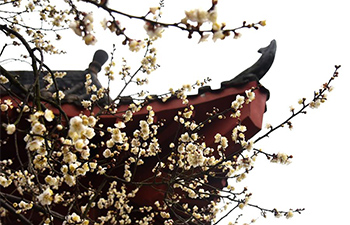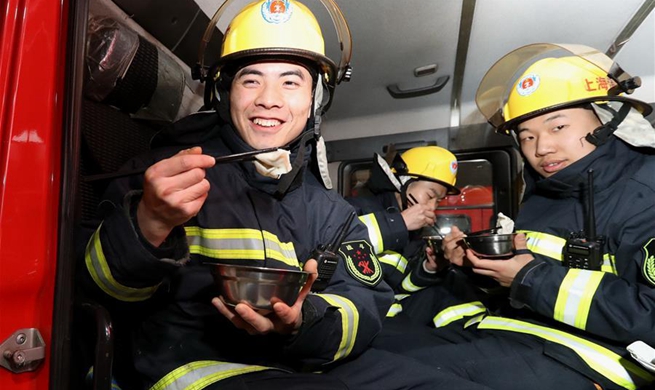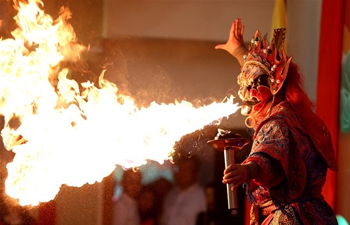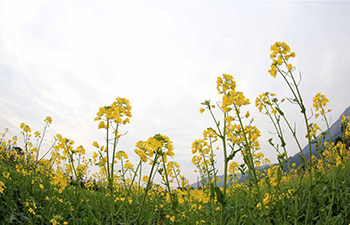BEIJING, Feb. 15 (Xinhua) -- On the eve of the Chinese Lunar New Year break Thursday, people across China are celebrating the most important yearly festival in various ways.
SKY-HIGH FESTIVAL GREETING
"I am the pilot of this flight. I wish you all a very auspicious New Year!" said Brazilian pilot Andre Luiz.
It would be Luiz' 12th year working in China. And on this New Year eve, he would be on a two-hour flight from north China's Tianjin to Xi'an, capital of northwest China's Shaanxi Province.
The Spring Festival has always been a busy time for pilots. Luiz remembers he has worked on New Year's eve since he came to China to work for Okey Airways (Okair), the country's first private air carrier.
"One Spring Festival eve years ago, I was on a night flight to south China's resort city of Sanya, when I saw a beautiful fireworks display in the night sky out of the plane's porthole," said the 53-year-old pilot.
Luiz's family have lived in the Chinese cities of Beijing and Tianjin, and have been familiar with Chinese life such as bullet trains, using Alipay e-payment and shared bikes.
BIG FAMILY BANQUET FOR 156 ORPHANS
A red tablecloth, red paper cutting on the windows and red lanterns turned a classroom into a banquet hall at a child welfare house in Luohe City, central China's Henan Province.
All 156 orphans in the house celebrated the New Year eve with their teachers and guardians at their most important yearly family dinner.
The New Year eve has always been the most exiting time of the year for the children. With the help of the teachers, they prepared the festival arrangements and performance for the festival banquet.
"At this festival, each of us can have red envelops with money and a suit of new clothes," said Qiu Hua, a girl in the house, who prepared her new clothes on her bedside for the first day of of the New Year.
One of the musicals that the children were rehearsing is called Mama Teachers.
"I am a child at home, but am called Mama here by the children. At first, I felt embarrassed. But now I am used it. Children really feel being more cared for, and teachers feel more responsibility to attend to the orphans," said Li Longzhen in her 20s, who joined the work in 2017.
VILLAGE GATHERING AT NEW YEAR EVE
In the outskirts of Shanghai, a big banquet was prepared Thursday for 500 villagers, which was set out by Lin Caiping, 35-year-old deputy Communist Party chief of Caozhong Village.
"The home village roots have been more and more cherished, as the rural part of Shanghai have been more urbanized. Villagers coming back for home gatherings hope to meet their childhood friends during the festival," Lin said.
The banquet was held in the village hall, where photos showed the village's transformation from adobe shacks to two-storey private buildings and residential communities of high-rise buildings.
The village hall is a communication place for villagers to sustain folk traditions.
Lin said in the outline of major tasks and targets for the rural revitalization strategy, the Chinese government seeks to achieve important progress featuring strong agriculture, a beautiful countryside and well-off farmers.
"Beautiful countryside is not just about the environment. It should sustain the local accent, festival customs and cultural heritage. The grand New Year gathering can be the most important occasion to sustain that," Lin said.
NIGHTSHIFT WITH FAST
It was the first Spring Festival for Qian Lei from the National Astronomical Observatories of China to be on duty to watch the world's largest single-dish radio telescope, known as FAST, in a deep and round karst depression in southwest China's Guizhou Province.
"My work today is mainly to trace two pulsars that FAST has identified and monitor the big nebula of the Andromeda Galaxy," said the 36-year-old engineer from Beijing.
Qian's wife and six-month-old daughter still live in Beijing. His 74-year-old father and 66-year-old mother came a long way from Yunnan Province to join him for a Spring Festival gathering with FAST.
"It is a great thing for my son to work for such an immense project," said his father.
Installed in the remote mountain, the telescope has a receiving area equivalent to about 30 football fields. Observers like Qian use the FAST vast dish made up of 4,450 panels to search for signs of extraterrestrial life and to observe distant pulsars -- tiny, rapidly spinning neutron stars believed to be the products of supernova explosions, like the galaxy's very own fireworks.

















